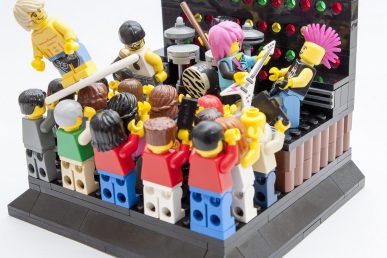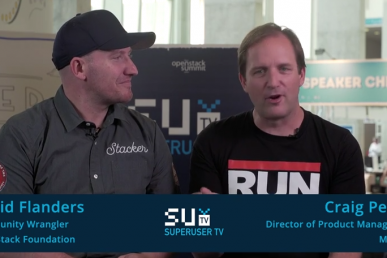SAN FRANCISCO — Day two keynotes at CoreOS Fest covered a lot of ground: project updates, Oracle’s announcement that it’s stepping up for community contributions and, yes, solar flares.
First Brandon Philips, CoreOS CTO, talked about his company’s commitment to open source calling it “almost necessary today” given the number of people on the internet and getting on the internet.
Developers are and always will be “outnumbered – and you can’t train your way out of it. It’s an intractable problem.” What got them excited when starting out 3.5 years ago was the idea of a portability layer – making sure the apps they build can move between various set-ups. “We have a responsibility to build software systems that do right by the people coming on the internet.”
Moving on to containers, he outlined a number of reasons why it was necessary to build Container Linux: containers push the Linux kernel in new ways, they require the latest Linux for security and performance as well as platform-wide support.
“Like any open source project it’s an ongoing mission, we are continuing to work on this.”
What’s next: project updates
He also shared updates on a couple of projects, including
CNI (the pod-native container engine formerly known as rkt plug-in) is now a part of the CNCF.
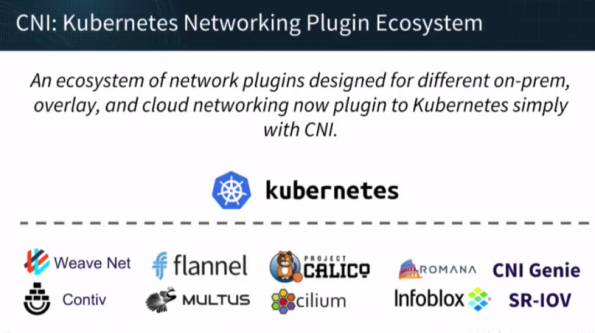
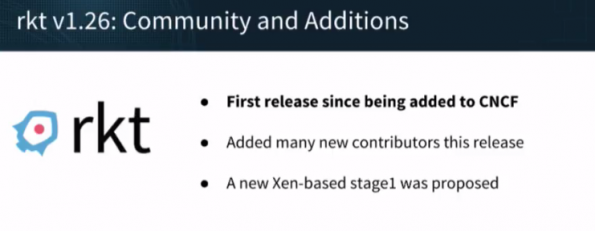
There were also updates on Clair, an open source project for the static analysis of vulnerabilities in appc and docker containers. 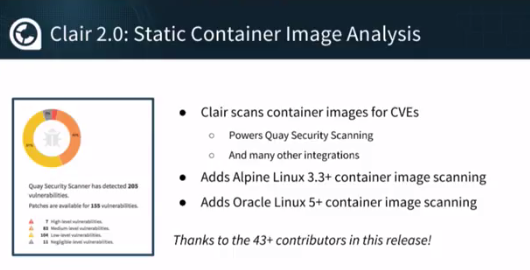

State of K8
Philips then gave a state of Kubernetes address – noting that the task was much easier than in his experience in the Linux kernel community due to the relative organization of the former. However with 1,500 contributors across 15 time zones it’s a “huge democracy.”
To avoid the downfalls of democracy — see Boaty Mcboatface — it’s better to provide some direction and a frame work. “The internet tends towards trollish behavior – people left undirected will go to areas that are entertaining. You ask the internet for something and and they will give you a meme back.” To that end, they kicked off a bootstrap committee whose job it is to get a steering committee in place by August 1.
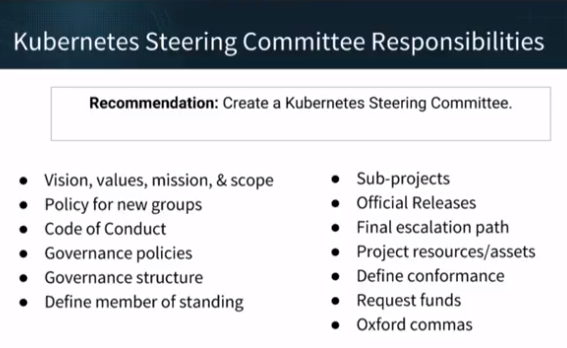
What’s in store
Here’s a rundown of what you can expect coming up:
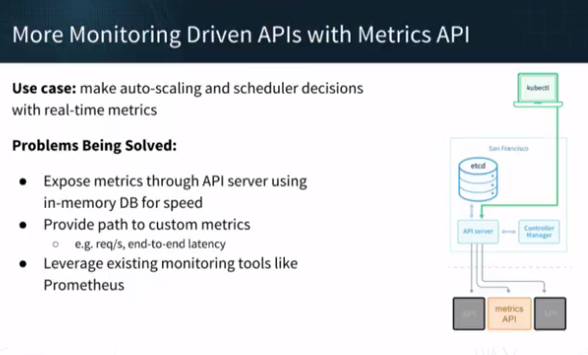
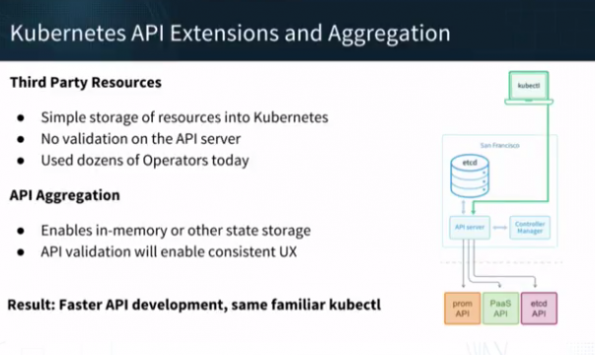
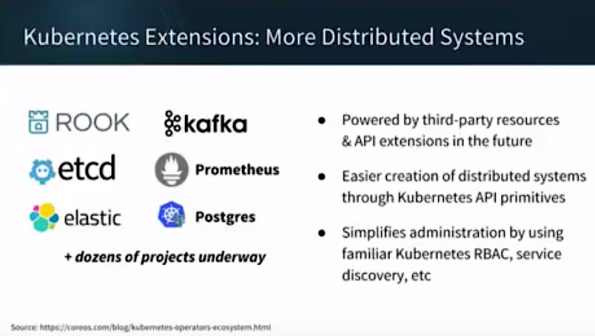
Finally, Philips says that the other upshot of all this activity is that tons of people are learning Kubernetes. “There’s a lot of momentum… people are moving from one set of technologies to another and it’s changing their day-to-day work.” Philips predicts more demand for both training and jobs as a result.
Oracle dives into the community
Mark Cavage and TJ Fontaine of Oracle took to the stage to talk about what their company is up to — and make a strong commitment to the community. Oracle is expanding its container and open source software commitment. They’re already working with CoreOS to bring CoreOS Container Linux to Oracle Cloud infrastructure and dedicating engineering resources to Kubernetes.
“People don’t realize that Oracle has invested really heavily over the last few years in becoming a hyper-scale cloud provider,” Cavage says. We have a true public cloud optimized for workloads, especially bare metal capabilities, he adds.
Both @wercker and @oracle are committed to @kubernetes and its ecosystem Contributions to follow! @mcavage @tjfontaine on stage #coreosfest pic.twitter.com/65Z9Sznj92
— Micha Hernandez v L. (@mies) June 1, 2017
In the coming months, expect to see certified images from Oracle and CoreOS but they also plan to “earn their stripes” in the community by answering questions on Slack, Stack Overflow, triaging issues on GitHub and improving documentation because “it takes more than talking, it takes action” to be good community members, Fontaine says.
Might as well be wonking on the sun
In one of the better keynote curveballs of the conference season, Dr. Lucianne Walkowicz, an astronomer at the Adler Planetarium in Chicago, gave a talk on the internet and solar flares.
“I know how much engineers love chaos,” Walkowicz said, adding that she hoped to terrify the crowd assembled on a foggy San Francisco morning.
Some 158 years ago, what became known as the Carrington Event — incredibly bright Northern Lights — fried the reigning technology of the day. The telegraph network went completely haywire – machines were set on fire and it induced enough current that people communicated without wires.
Today we’re in in what she called a “relatively chill” period of the solar cycle but it won’t last forever. Be on the watch for “pearl-clutchy” weather reports such as recent ones about “holes” on the sun but she reminded an increasingly quiet crowd that the sun, essentially a giant magnet, can influence what happens on earth.
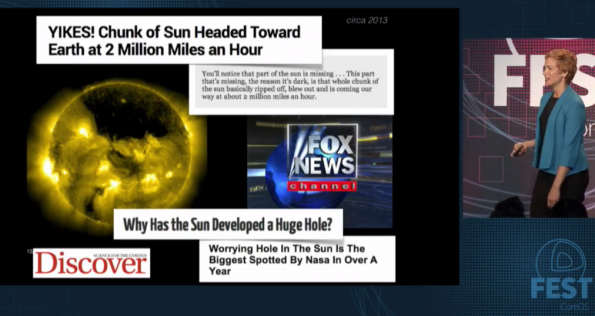
“Now that we all have computers in our pockets and rely on the internet, events like sun flares that launch out towards earth can impact us,” she says.
Power grids are old and fragile as well as interdependent, she says, citing the case of a surge in Quebec that melted a transformer in New Jersey. These transformers cost tens of millions of dollars and take a year to make, she says, “it’s not like you have an extra one hanging out back at the power plant.” It can also affect satellites and GPS, so even if you were lucky enough to have your smartphone unplugged at the time of the flare, you still would be able to charge it or actually make a phone call with it.
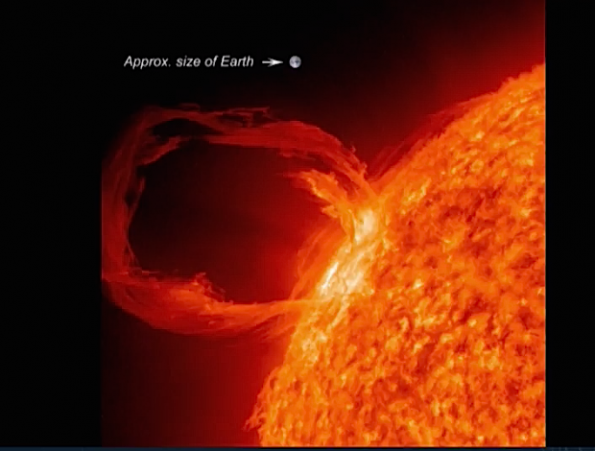
For a “small silver lining,” Walkowicz brought out two competing reports on the effects of what’s called “severe space weather.” The first, a doom and gloom one, was downplayed by the second report conducted by JASON for the Department of Homeland Security. One of the reasons: the first report used proprietary algorithms so the predictions couldn’t be reproduced. “As an astronomer, this is how I think of open source — reproducibility is big thing in science, it’s as fundamental as our ability to buy equipment and test things out.”
That said, she left the audience with food for thought about the risks for data storage. In the next few years, the sun will become more active and the workarounds available now (build everything in triplicate) don’t scale for consumer electronics. If you’re interested in reading more, she suggests checking out the book “The Grid” or “Lo and Behold” the Werner Herzog documentary on the internet, where she’s also interviewed.
“In some cases when your phone doesn’t work and you think it’s a software bug, it might actually be space particles,” she says. “Which sounds cool but will really be a pain in the butt.”
- OpenStack Homebrew Club: Meet the sausage cloud - July 31, 2019
- Building a virtuous circle with open infrastructure: Inclusive, global, adaptable - July 30, 2019
- Using Istio’s Mixer for network request caching: What’s next - July 22, 2019

)




